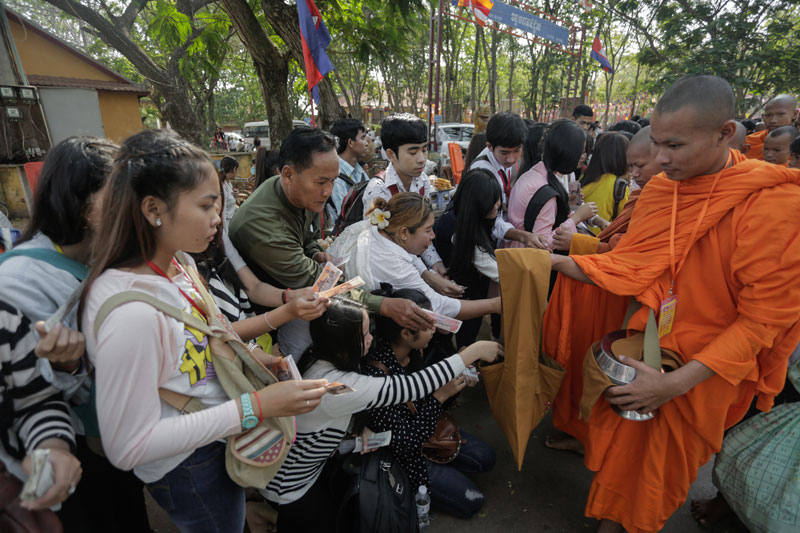As the sun rose over the hazy plains of Kandal province Tuesday, processions of monks and nuns wound their way to the foot of Oudong Mountain to mark the Meak Bochea festival.
By mid-morning, some 4,000 Buddhists, including Deputy Prime Minister Yim Chhayly, had also congregated at the base of the mountain to offer alms on the day Buddha is said to have prophesized his own death.

The country’s largest celebration of Meak Bochea has historically been held at Oudong Mountain because a stupa housing relics of the Buddha had been kept at the summit.
Tuesday was the second time the ceremony was held at the mountain after the relics—said to be the hair, teeth and bones of the Buddha—were stolen in December 2013. The relics have since been recovered and are being stored at the Royal Palace in Phnom Penh.
Rong Phearum, director of the provincial cults and religion department, said during the ceremony that despite the absence of the relics in the now boarded-up stupa, Meak Bochea’s rituals still held huge significance for Cambodia’s observant Buddhists.
“Even last year, soon after the relics were stolen, we held the ceremony because all Khmers respect these Buddhist traditions and are still deferential to the Buddha’s soul,” Mr. Phearum said.
“Even though [the relics] are not at the stupa, people’s hearts are still here,” he said, adding that he hoped the relics would be returned in time for the larger Visak Bochea festival in June that celebrates the Buddha’s birth, enlightenment and attainment of nirvana.
Tuesday’s two-hour ceremony began at about 8 a.m. with a series of prayers led by Tep Vong and Bou Kry, leaders of the country’s Mohanikaya and Dhammayuth Buddhist sects, respectively. Monks and nuns then walked slowly in a circle as they received offerings of money and food from worshippers, including government officials and representatives of the Thai, Vietnamese and Indian embassies.
Ang Choulean, an ethnologist specializing in Cambodian traditions at the Royal University of Fine Arts, said Meak Bochea holds little significance for the country’s youth, who he believes are largely ignorant of the festival’s meaning.
“The young generation is not really aware of this tradition, especially in the cities. In the countryside, maybe more people know,” Mr. Choulean said.
“I think it is minor in comparison to what happens in three months to commemorate the birth, the enlightenment and nirvana. In addition, of course, today young people become more and more ignorant [of] this event,” he added.
Young Cambodians enjoying the public holiday on Phnom Penh’s riverside, however, said the tradition was important to them.
“This is not like any other holiday,” said Chamroeun Kimhong, a 15-year-old student from the city’s Tuol Kok district. “This is a great day where we respect our Buddhist traditions…. I think it is very important.”